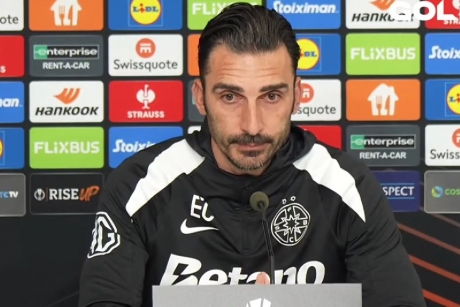This year's National Congress of Radiology and Medical Imaging in Craiova, supported by Siemens Healthineers, has brought on stage Romanian and international specialists to talk about the latest trends in the field. One of the guest speakers, Adrian Brady, the president of the European Society of Radiology (ESR), says he was impressed with the quality of work presented at the congress by Romanian radiologists.
As technical developments have equipped radiologists to deliver better imaging, the demands imposed on them have increased as well, turning them into "almost a victim of their own success," Professor Adrian Brady, the president of the European Society of Radiology (ESR), says.
Developments such as AI-based solutions have opened up exciting possibilities but also a host of ethical implications that need to be considered.
Present at this year's National Congress of Radiology and Medical Imaging in Craiova, where he was among the speakers, Brady answered several questions on the challenges faced by radiology professionals, the latest trends in the field, and the work of the European Society of Radiology.
Part of the mission of the European Society of Radiology (ESR) is to unify European radiology. Could you tell us a bit about what this work entails and where the variations are?
Adrian Brady: Firstly, most countries have their own national radiology society - like the Romanian Society holding this congress, and they're fantastic - but we have found that there is also scope and need for a much larger society that brings together expertise from many different countries.
For example, you have great speakers at the session I've just been at from within Romania on cardiac CT, but professor [Christian] Loewe from Vienna is here as a representative of the European Society of Radiology, and he can bring something additional to the meeting.
So we found that there's really been a need for that sort of transnational education - number one.
Number two - another very important thing the ESR does is try to standardize education and educational standards. For example, the session that we had this morning with professor [Laura] Oleaga talking about the European Diploma of Radiology - this is something that the European Society has established in order to try and provide a benchmark that is exactly the same whether somebody takes the exam in Romania or Poland or Ireland, my country; it is a way of benchmarking one's knowledge, performance and training against everybody else in Europe.
And then, of course, by virtue of our size, we can leverage a lot of access to provide education that might not necessarily be available on a smaller scale. The congress we hold every year in March in Vienna is an example of that. We are able to draw people together from all over the world, not even just Europe, to provide the best educational opportunities that exist, and that is open to all ESR members. That is a resource that people find hugely valuable. We would usually have 18,000 to 20,000 people attending the congress coming from all over Europe, so they clearly find that valuable.
Our mission is not just to standardize education but also to make sure that we can draw upon a vast amount of expertise to make it available to everybody. There are some countries that have better-organized and better-established national societies and programs than others, but everybody gains something from what they do.
What are the main challenges facing radiology professionals and how can they prepare better to take them on?
Adrian Brady: I've been thinking a lot about this lately because, to some extent, we've become almost a victim of our own success. In the 1940s, 1950s, 1960s, radiology was a niche specialty. The modalities available were limited to plain radiography, a bit of angiography, some contrast studies in the GI tract, some basic nuclear medicine. The speed at which radiology moved was relatively slow. If you had an X-ray today, the report might be available tomorrow because somebody had to dictate it and type it.
Now we have so many more modalities that are available to us - CT, MR, ultrasound. We can get much more information from them, and we can do studies more quickly and produce reports more quickly. That has meant that the importance of imaging in clinical care has grown hugely. That's wonderful.
But, as I said, we have become a victim of our own success because we are so good at what we do in terms of helping patients that the need for our services has grown hugely. So everybody wants everything instantly. That is good in a sense because it is valuable, but it places huge burdens on staff and on equipment. So, doing all the work that people want us to do is a challenge. And doing it as quickly as they want us to do it is a challenge. What that means is that a lot of radiologists are forced to work in an environment where they are sitting at a workstation producing reports as quickly as they can all the time, and they have less time to deal with patients directly and less time to deal directly with referring colleagues than used to be the case. That is what I mean by saying we are victims of our own success. We're doing so much good work that we don't have time to do the things that would make that work even better, which is to liaise directly with referrers and to see patients directly. That is one challenge.
Another challenge that a lot of people have been worried about in recent years is artificial intelligence. There were famous comments made back in 2016 that there was no need to keep training radiologists, that we would all be redundant in five years, that AI would be better at what we do than we are. Now, those comments weren't made by people who really understood radiology, but clearly they were wrong. Nonetheless, the way we practice is changing as a result of artificial intelligence. A lot of people are frightened a little bit of its implications. I wouldn't say it's impacting people's willingness to train as radiologists, but it has made some younger doctors a little bit frightened that the world of radiology in the future might be very different from the one they know now.
There are lots of other challenges as well, but these are probably the two biggest ones that I would see right now. And going back to the question, how can we deal with them? I don't have all the answers to that, but I think the key to responding to challenges like this is never to lose sight of the fact that we are clinical doctors.
We're not just people who sit in a dark room at a workstation producing outputs, producing reports. We're doctors just like the cardiac surgeon is a doctor, the cardiologist is a doctor, and we have a role in patient care. If we never let anybody else forget this point, if we never forget it ourselves, and if we constantly emphasize that we need to be in the clinical space, seeing patients, meeting face-to-face with our referring doctors and being part of the decision-making team, then I think we'll deal with a lot of the other challenges.
You mentioned AI. What are some other trends you expect to develop in the field of imaging in the coming years?
Adrian Brady: Well, AI is a big one. That's a really hot topic at the moment.
There are some other technical developments that are changing a lot of what we do. Photon counting CT is one that one hears a lot of these days; it is a wonderful new physical development in CT that is really changing the capability of CT to image patients and to image them safely, at lower doses or with lower contrast. And while it may seem like just a technical tweak of a modality that has been around since the 1970s, it is much more than that, actually. It is a huge leap in terms of what we can do. We heard a very good talk on that yesterday [e.n. September 22].
Another one is the increase in functional imaging. For most of the time, radiology has been about anatomical imaging. Increasingly, we are now able to do functional imaging with radiotracers, with PET-CT, some nuclear medicine techniques; that adds information in terms of functional parameters of disease rather than just what they look like, but actually how things work. And we can ally our imaging techniques to that to get an awful lot more information that is specific to patients and helps guide patient-centered and patient-specific treatments.
Theranostics is a great new development. It's more in the nuclear medicine field than in the diagnostic radiology field, but there's a good deal of crossover. A lot of diseases that previously were treated in a sort of a blunderbuss fashion, if you like, can be treated much more precisely with radio-labeled treatments in the theranostics field.
And then the last one I'd mention would be the continuing growth of interventional radiology, my own subspecialty. We can do so much more now to treat people with interventional and minimally invasive techniques than was the case in the past. In many cases, we have managed to find ways and develop ways of treating patients that don't require open surgery or don't require high morbidity incisions and are often extremely successful.
Going back to AI, several speakers mentioned the ethical concerns associated with it. What are the European Society's recommendations in the field?
Adrian Brady: Some years ago, we joined with the North American societies, the [American College of Radiology] ACR, the [Radiological Society of North America] RSNA, and the Canadian Association, to write a multi-society position statement on exactly what you've just asked me - about the ethical implications of introducing AI in radiology. I was involved in that project personally.
There's a huge range of ethical issues that arise with AI. The one that most people are instantly aware of is data. If you make your data available to train an AI algorithm, who owns the data? Who owns the algorithm? Who benefits from the algorithm? There are all sorts of things that need to be worked out. If individual patients' data is being used in that way, then individual patients' privacy must be protected, and their rights in terms of ownership of data have to be protected. There are potential dangers in a lot of AI applications of privacy being eroded. So, tool developers, algorithm developers, and users have to be very careful about how they use data.
Then there are areas of ethical implications in terms of how you apply AI tools in the clinical space. For example, if you develop a tool to detect early lung cancer in a population that is all Caucasian and all in one country, and then you apply it in another country where there's a much more mixed migrant population, will the tool perform the same way on a population in which it hasn't been trained? In most instances, in fact, it won't. But you need to be aware of that, and you need to make adaptations to make sure that it's performing safely. And there are lots of other things. I could go on forever about this because I've been involved in this area of work.
But it is a minefield, and as it happens, the ESR and a number of other societies are presently working on another multi-society statement where we will be trying to give practical advice both to developers of AI tools and to those who may consider purchasing and using them, and those who are using them on an ongoing basis.
We will be trying to give them practical advice on what are the things you need to look for, what are the things you need to measure, what are the things you need to monitor, and how to make sure that what they're using is safe and stays safe throughout its life cycle.
What are your takeaways from the congress so far?
Adrian Brady: I'm hugely impressed at the enthusiasm of people. I'm hugely impressed with the numbers here. I think this is the largest congress in terms of number of attendees that you've ever had, or so I've been told.
The enthusiasm is absolutely wonderful. The numbers of people who were at the EDiR [European Diploma in Radiology] session, for example, trying to get a sense of what the European Diploma exam is like and how it might fit into their lives were huge. The hall was almost full.
The quality of work that I've seen presented here and seen presented previously during ECR [European Congress of Radiology] 2023 from Romanian radiologists has been fantastic. It's as good as you'll get anywhere in the world in terms of academic presentations and quality. I'm just hugely impressed at your society and the congress and everything that's happening in the specialty here.
*This Healthcare Trends article is supported by Siemens Healthineers.
























 English (US) ·
English (US) ·  Romanian (RO) ·
Romanian (RO) ·